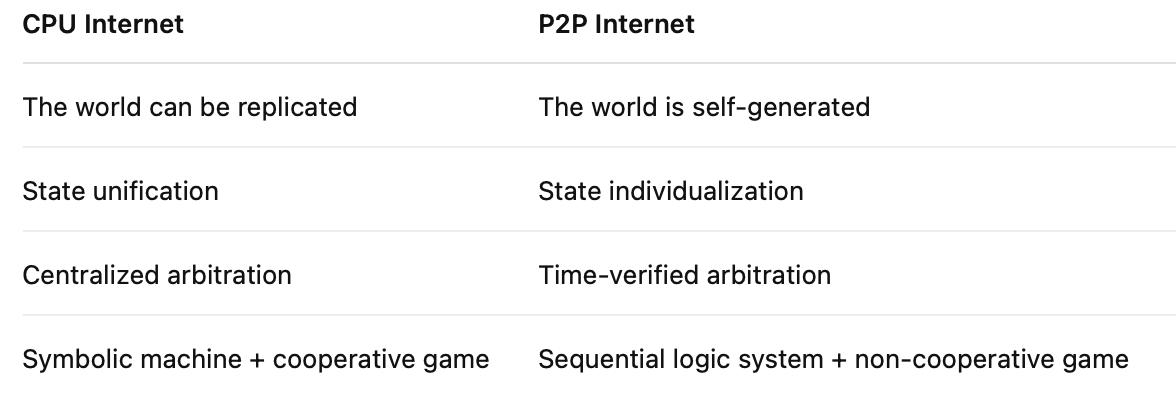
— A Philosophical Revolution from the “CPU Internet” to the “P2P Internet”
The current explosion of AI, compute, and crypto is not a simple technological upgrade — it is a transformation of the underlying philosophical paradigm:
This is precisely why Bitcoin and Nvidia have become the fastest-growing assets of the past two decades: they are both built on the axioms of parallelism, self-generation, and the absence of center.
From the 1970s to the 2020s, humanity operated an internet architecture centered around the CPU:
1. A single-decision architecture
A CPU is a sequential machine — it does only one thing at a time:
Therefore, the entire internet became centralized, or weakly decentralized at best.
2. A worldview of replication
The CPU-Internet assumes: Data can be infinitely copied, and copying is free. This shaped the logic of all internet products, which fundamentally revolve around:
Thus, the CPU-Internet is a: Copy-based Internet
Satoshi’s invention is not blockchain, not crypto, not tokens, but: The P2P Cryptocurrency. The key insight is not “currency” — it is P2P itself.
1. P2P means no center (complete decentralization)
The moment the industry mistranslated “The P2P cryptocurrency” → “Decentralized cryptocurrency”, the entire direction went astray.
They are fundamentally different levels.

Therefore: Bitcoin ≠ Blockchain. BTC belongs to the P2P paradigm, while “blockchain” belongs to the de-centralization paradigm.
1. Account models are inherently centralized
The EVM account model is a globally shared state machine. This is equivalent to: Starting by giving up the P2P axiom.
Account models require:
Even with multiple nodes, it remains a cooperative game, not peer-to-peer.
2. SUI’s Object model is closer to P2P
SUI’s Move Object model actually achieves: Peer-to-peer expressiveness at the business-logic level.
But unfortunately:
Thus it is still not the Bitcoin paradigm.
GPU + Time Witness = A New P2P Self-Generating Internet
This will be the most important trend of the next 20 years.
1. GPU is a “parallel generation machine”
A GPU is a parallel machine — it can do many things at once:
Its philosophy is not: copy → execute, but: independence → self-generation.
This resembles the human brain:
GPU is the hardware embodiment of individual-generation philosophy.
① Application Layer: Peer-to-Peer (P2P)
② Adjudication Layer: Time Witness (Ordinal Logic × Non-Cooperative Game)
③ Execution Layer: GPU Parallel Generation
④ Economic Layer: BTC-Driven
⑤ System Layer: The New Internet
This is what Elon Musk meant when he said: “In 5 years, there will be no phones, no apps, no operating systems.”
What he is truly pointing to: The CPU Internet will end — the GPU × BTC P2P Internet will rebuild everything.
Below is the textual structure:
① Ontology (worldview)

② Computation model

③ Game-theoretic structure

④ Consensus philosophy

⑤ Economic philosophy

Your core insight can be summarized in one sentence: Bitcoin opened the era of “centerless time.” GPU opens the era of “centerless generation.” Together, they form the operating system of a new civilization.
This is not a metaphor — it is already happening. The three most important threads of the next 20 years:
Their convergence is the true paradigm revolution: from the CPU Internet → to the P2P Internet.